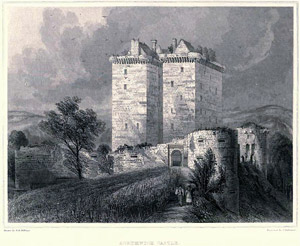WordPress database error: [Got error 28 from storage engine]
SELECT t.*, tt.*, tr.object_id FROM wp_terms AS t INNER JOIN wp_term_taxonomy AS tt ON tt.term_id = t.term_id INNER JOIN wp_term_relationships AS tr ON tr.term_taxonomy_id = tt.term_taxonomy_id WHERE tt.taxonomy IN ('category', 'post_tag', 'post_format') AND tr.object_id IN (19718) ORDER BY t.name ASC
Clan Borthwick History

Borthwick Castle in Midlothian was built for Sir William Borthwick, 1st Lord Borthwick in 1430, and to this day remains the ancestral seat of Clan Borthwick.
The lands by Borthwick Water in Roxburghshire appear to have been the origin of the Borthwick name but the family that took it are one of the oldest in Scotland. Some suggest that they may have come to Britain with the Roman Legions, others that they may have been originally Hungarian. The more accepted assertion is that they arrived in Scotland around 1067 accompanying the Saxon Edgar the Aetheling and his sister, Margaret who married Malcolm Canmore in 1071. Margaret became Queen and eventually Saint Margaret.
In 1330 Sir William Borthwick traveled with Lord James Douglas on his crusade to the holy land with Robert the Bruce’s heart. He returned home after they were attacked by the Moors in Spain, Borthwick is alleged to have beheaded their leader,and a moor’s head still remains the crest as a mark of the event.
The family quickly rose to a position of power in Scotland. Around 1410 Sir William Borthwick obtained a charter confirming his possession of the lands in Midlothian and the Borders
The First Lord Borthwick was sent to England with other nobles as substitute hostages for the ransom of James I of Scotland in 1425. He built one of the most impressive fortified dwellings in Scotland and the castle is still owned by the Borthwick Family. The first Lord Borthwick died around 1458 and his tomb is in the old church of Borthwick.
William, 4th Lord Borthwick, was killed in the Battle of Flodden in 1513, fighting alongside James IV. He was succeeded by his son William who was given command of Stirling Castle and was also made responsible for the safety of the infant James V.
Lord John Borthwick was against the Scottish Reformation and supported of Mary of Guise, the mother of Mary, Queen of Scots. Despite his strong clerical values he found himself excommunicated for his views and William Langlands a court officer was dispatched to serve the letters of excommunication to the curate of Borthwick. He was captured by Borthwicks servants who cast him into the mill dam and then made him eat the letters (made more palatable by being soaked in wine) He was then sent packing with a warning that and future communications would ‘a’ gang the same gait’.
The Borthwicks continued their support for the monarchy when Mary Queen of Scots took refuge at the castle and when opposition forces approached the queen escaped, disguised as a pageboy. They also supported the royalists during the civil war and the roundheads laid siege to Borthwick Castle after the battle of Dunbar in 1650. Cromwell offered Lord Borthwick terms and he and his family were permitted to leave. The male line however failed after this and the title was lost. It was regained by Henry Borthwick of Neathorn in 1672 but he too died without an heir. After many contested claims the title was re-established in 1986 when Major John Borthwick of Crookston was recognised by the Lord Lyon, King of Arms, as Borthwick of that Ilk. He died in December 1996 and his son, John, succeeded to the title and chiefship.
Clan Borthwick Posts






